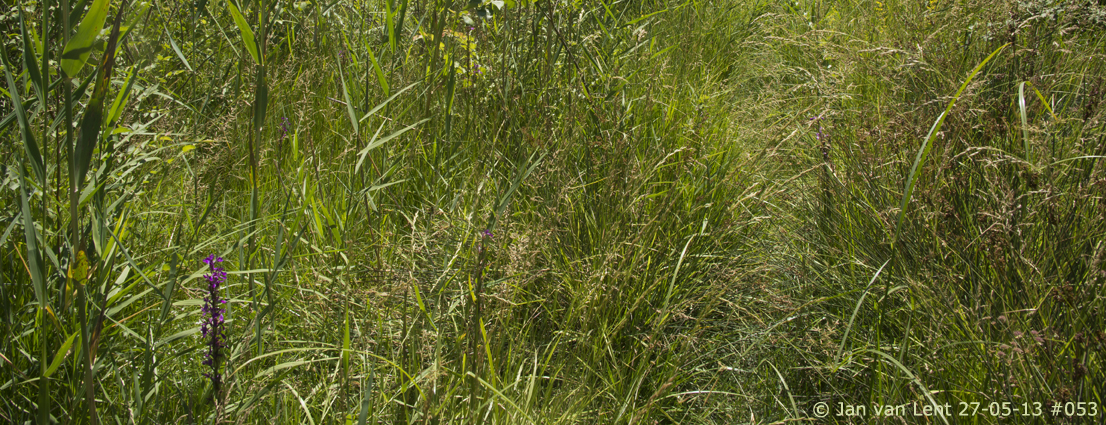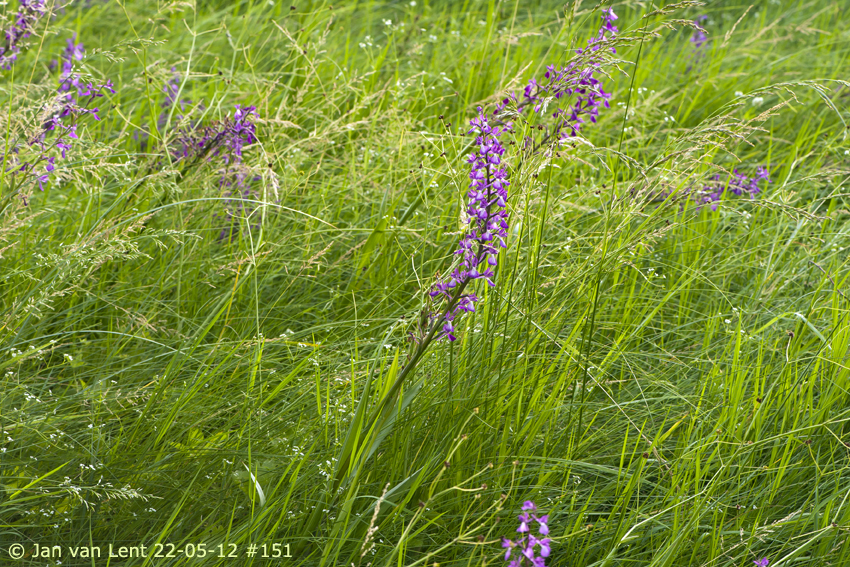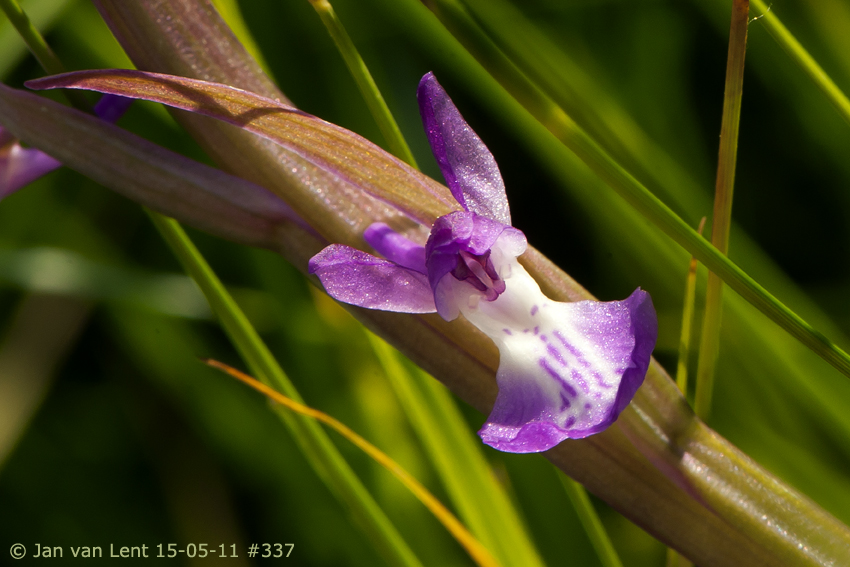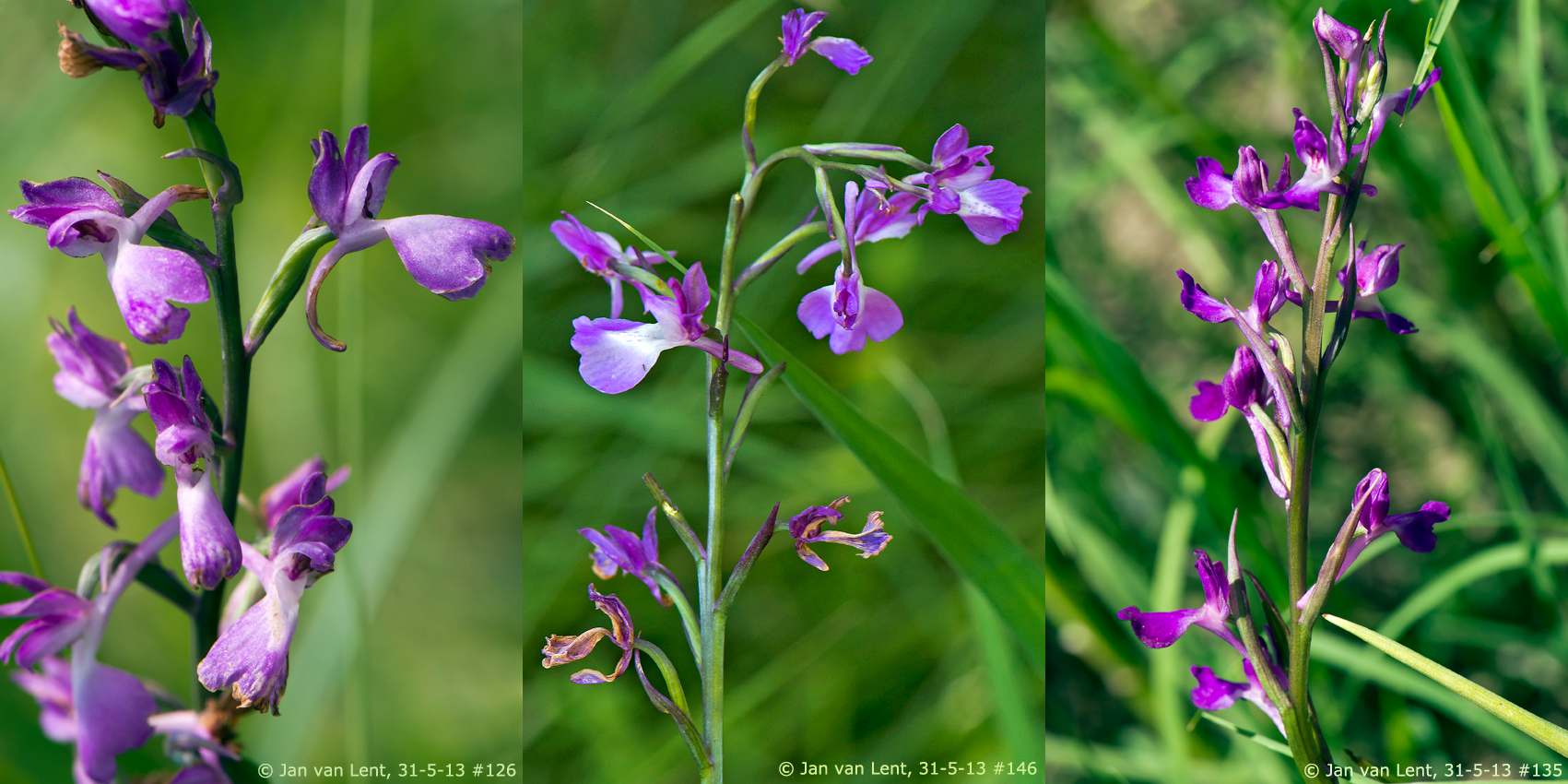Habitat: Larisos corner (the reeds).
The Larisos reeds-marshland © Jan van Lent 27-05-13 #053
REMARKS: On the North side of the Gulf of Gera – Pigadakia (Dipi) – and between the reeds (left and right) on the intersection to Plomari – the Larisos corner – there are lots of big Orchis to discover, all from the ‘old’ Orchis palustris group (DELFORGE 2005), nowadays Anacamptis BPC 1997* (IPNI* confirmed). To make it easier for the ‘amateur’ orchidologist to recognize those species I will quote DEVILLERS ET AL. (Lesvos 2010): ‘Paludorchis palustris, an alkaline mire specialist, has long been known to have substantial populations along the northern shore of the Gulf of Kalloni and the western and south-eastern shores of the Gulf of Geras (CANDARGY 1897, GOLZ & REINHARD 1981, 1989A, BIEL 1998, KARATZAS & KARATZA 2009, DELFORGE 2009b). It is difficult to completely evaluate their characters at that stage, but they appeared to represent var. elegans (or Paludorchis elegans), as is usually expected for Lesbos plants (BUTTLER & NIESCHALK 1979, DELFORGE 2009b). The taxonomy of what DELFORGE (2005) calls the palustris subgroup of the [P.] laxiflora group is, however, complex (e.g. BUTTLER & NIESCHALK 1979), and KARATZAS and KARATZA (2009) identify five Paludorchis on Lesbos (P. dinsmorei, P. elegans, P. laxiflora, P. palustris and P. pseudolaxifiora).’
So according to KARATZÁ (Lesvos 2008) five different ORCHIS, but nowadays you can apparently choose between Orchis, Anacamptis or Paludorchis, and maybe next year between a few more GENUS names. And I was a clairvoyant when I wrote: ‘It’s all about people with different views and orchids with different names; in short, it’s a hornets’ nest!’
(Anacamptis group) Orchis dinsmorei (SCHLECHTER) H. BAUMANN & DAFNI 1941;(Anacamptis group) Orchis laxiflora LAMARCK 1778;
(Anacamptis group) Orchis palustris JACQUIN 1786;
(Anacamptis group) Orchis pseudolaxiflora CZERNIAKOVSKA 1941;
(Anacamptis group) Orchis elegans HEUFFEL 1835.
Very big and very elegant: not Or. elegans but Or. palustris, © Jan van Lent 22-05-12 #151.
HABITAT: If you drive from Kalloni towards Mytilini you pass the exit to Plomari on your right and you see a huge field of reeds. Last year they burnt them down but today they are there again. This reed-bed is the home of a few of the biggest Orchis in the world! For instance I photographed an elegans with a length of 1m.20! But if you come too early to this habitat, for instance in the middle of April, you sure get wet feet, even if you wear rubber boots! And there is maybe only Orchis laxiflora around at this time. The hunting time for those big Orchises is between the beginning and the end of May. According to Karatzá the first to flower should be Orchis dinsmorei and the last Orchis elegans. So do take the exit to Plomari and stop directly on the left site of the road. First eat a perfect sandwich and drink a ‘frappé’ at the snackbar on the corner, put on your rubber boots and jump into the marshland. Have a nice swim!
So now there is only one thing left which should have your attention and that is: which Orchis is which?
Orchis palustris, Larisos reeds, © Jan van Lent 31-05-13 #097.
Orchis dinsmorei: very early flowering, small violet (aubergine purple) flowers with a very short, spotted lip and back folded side lobes.
Orchis laxiflora: lax inflorescence, no spots on a very stark backwards folded lip. (see blog 24: ‘Everybody Knows’ http://www.janvanlent.com/blog/?p=1944).
Orchis palustris: spreading lip with spots and stripes, spur not divided, as long as ovary, bracts ± equal to the flowers.
Orchis pseudolaxiflora: spreading lip, short spur, little shorter than ovary (on palustris half as long).
Orchis elegans; spreading lip with spots and stripes, longer leaves, three indistinct lobes and much longer bracts.
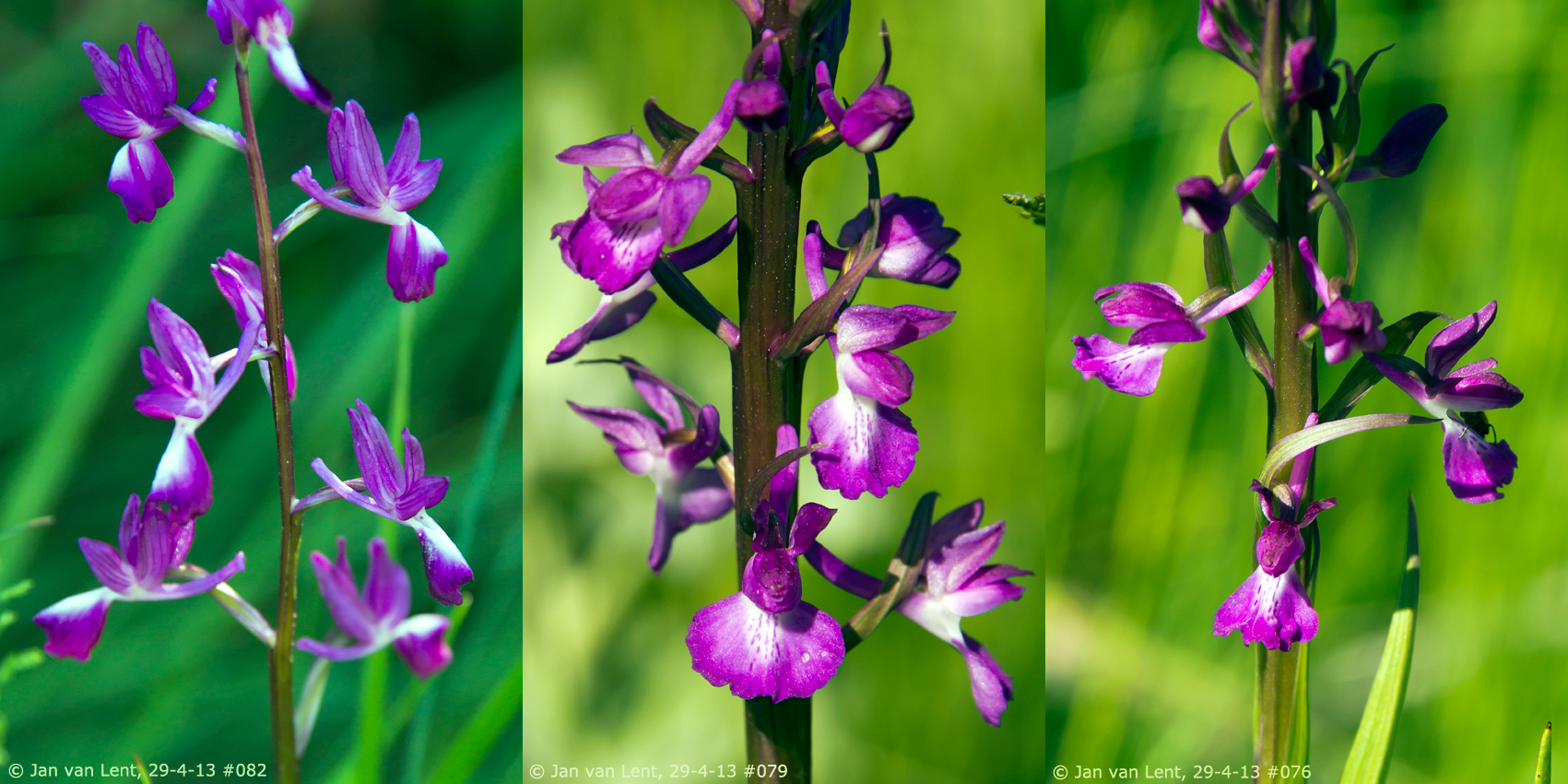
© Jan van Lent, 29-4-2013: O. laxiflora #082; O. palustris #079; O. elegans #076; Larisos reeds.
HUNTING: So I went 3 years (3-4 times a year) fishing in those reeds but I never caught O. dinsmorei… The earliest I caught were O. laxiflora, O. palustris and O. elegans (or maybe better: O. palustris ssp. elegans) together on the 29th of April this year. I visited this habitat before, on the 14th of April, but then the water was still so high that I had to wear my swim-suit and dive-equipment: in other words I couldn’t get in. And from the small hill where I was standing I couldn’t see any pink, purple or aubergine coloured Orchis rising above the reeds! But this year we had an exceptionally wet March and beginning of April, so maybe next year will be different…
Orchis elegans, Larisos reeds, © Jan van Lent 15-05-11 #337
DISTRIBUTION: Directly into Turkey with (KREUTZ, Turkey 1998). And yes, he describes the whole Palustris group from Turkey: Orchis dinsmorei (only on the Syrian border), Orchis elegans (at the Mediterranean coast down from Kuşadasi), Orchis laxiflora (all over Turkey), Orchis palustris (all over Turkey) and Orchis pseudolaxiflora (only in the east of Turkey). And I know that in the past Lesvos was Turkish (or rather Ottoman), but that doesn’t say that we have all their orchids over here! So let’s see what Greece has to offer:
PETROU ET AL. (Greece, 2011) – A. laxiflora – : ‘A European and Mediterranean species; it occurs throughout Greece.’ - A. palustris ssp. palustris -: ‘A European and Mediterranean taxon; it occurs mainly in north-western and central Greece, Lesvos, and possibly Corfu; there are reports about its occurrence in the Peloponnese, the Cyclades and Crete.’ - A. palustris ssp. elegans -: ‘A Balkan and Asian taxon; it occurs in the northern and central mainland and in Lesvos.’ Okay, so Lesvos has apparently a special position in the palustris group but PETROU doesn’t say anything about dinsmorei or pseudolaxiflora flowering in Greece, not even on Lesvos…
Let’s look into Europe, North Africa and the Middle East, the bigger view so to say. DELFORGE (2005) – Orchis dinsmorei -: ‘Eastern Mediterranean. From Israel north to Cilicia (Anatolia). – Orchis pseudolaxiflora -: ‘Eastern sub-Mediterranean and Asia. Central Anatolia east to Afghanistan and south to Yemen.’
And ‘we’ think we get the whole palustris group here on Lesvos on an orchid tray…
Orchis palustris, Larisos reeds, © Jan van Lent 19-05-11 #042
Orchis elegans, Larisos reeds, © Jan van Lent 15-05-11 #397
BAUMANN ET AL. (Europa mit angrenzenden Gebieten’2006): Orchis dinsmorei -: ‘Israel, Lebanon, W.-Syria, Turkey:Cilicia. Orchis palustris ssp. pseudolaxiflora -: ‘Distribution not clear. Certainly evidence from Algeria (Typus), Mallorca and Crete.’ And I didn’t mention their O.palustris ssp. pseudolaxiflora (Czerniak.) H. BAUMANN & R. LORENZ, did I?
But KRETZSCHMAR ET AL. (Crete & Dodecanese 2004) didn’t find O. pseudolaxiflora (or O. dinsmorei) on Crete or on the Dodecanese, only O.palustris and O. laxiflora. Orchis palustris flowers at one spot on Crete but not on Kasos, Karpathos and Rhodes. ‘Occurrence greatly reduced owing to human activity. On the spots where it has previously been found, only one is still valid to date, but even this is seriously endangered owing to the progress of tourist development.’ And: ‘The Cretan plants of Orchis palustris intermediate between var. robusta and ssp. elegans.’ Orchis laxiflora flowers on Crete, Karpathos and Rhodes but: ‘The occurrence of the species has been strongly reduced due to human activity.’
KREUTZ (2002): on Rhodes & Karpathos O.dinsmorei & O. pseudolaxiflora are not present, only O. laxiflora & palustris.
KREUTZ (Cyprus 2004): On Cyprus only O. laxiflora & palustris. O.dinsmorei & O. pseudolaxiflora are not present. And: ‘Numbers of the exceptionally rare Orchis palustris have declined considerably due to drainage and the absence of precautionary measures, to such an extent that it is acutely threatened.’ And: ‘The already very rare Orchis laxiflora has declined considerably due to drainage, fertilisation and ever intensifying agriculture. It is therefore especially threatened.’
Also on Samos(DELFORGE 2008) O.dinsmorei & O. pseudolaxiflora are not present, only O. laxiflora and O. palustris var. elegans, but: ‘both extremely local and endangered by the destruction of the rare wet biotopes’.
Last but not least our neighbour island Chios. According to DELFORGE & SALIARIS (2007) there are no Orchids of the palustris group flowering on Chios but TAYLOR (2012) has a different opinion: Orchis laxiflora flowers on four locations in Chios.
© Jan van Lent, 31-5-2013: O. laxiflora #126; O. palustris x O. laxiflora #146; O.palustris x O. elegans #135; Larisos reeds.
BIG BOTTOM-LINE: What all the authors of all the Greek orchid-books are sure about is the acute endangerment of all those marsh-orchids on all islands in Greece. And why should we (Lesvos) be not only the only island, but also the only habitat in Greece to have all those 5 taxa from the Palustris group? Is this because there is not a lot of ‘human activity’ and we don’t have ‘tourist’s endangerments’, only a sheep and goats overkill? Or was this wishful thinking by Karatza? In any case, even one month later I think we still have only three taxa in the Larisos-reeds: Orchis laxiflora, Orchis palustris and Orchis (palustris ssp.) elegans, and not an O. dinsmorei in sight. But a lot of hybridisation is going on between those three, and sometimes (later in May) it is almost impossible to see the differences between laxiflora, palustris & elegans. And that could lead to the conclusion that there is a fake, a pseudo-laxiflora around here, and of course there is a fake one, but pseudo? I mean, you clearly see the differences, but comparing them with your field guides makes you want to eat them. The field guides I mean of course. In early May you are standing in a marsh, you feet are sinking away in the mud, and then you should be bending over to measure the length and width of the leaves and try to see if they are keeled? You try that and the water is now entering your boots and creeping up your pants. You try to do one step ahead, swump, swump, ah; there is a smaller one, maybe nevertheless a pseudo-laxiflora then?
Jan van Lent, Lesvos 5-6-2013.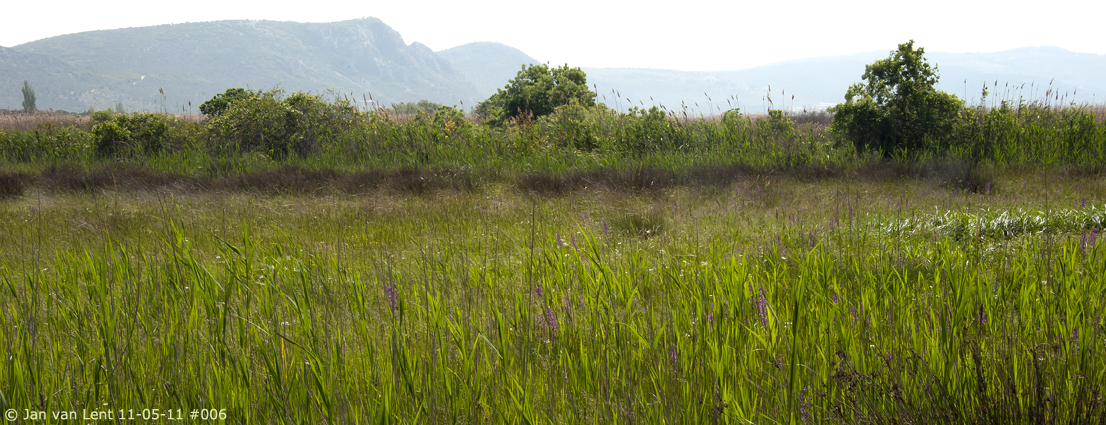
Big Orchis in the Larisos reeds-marshland © Jan van Lent 11-05-11 #006.
‘She’s not there’, The Zombies (1965):
www.youtube.com/watch?v=CKBRc8zNQ30
And for ‘naturalists’ who loved his guitar solos and missed his moustache: Carlos Santana (1987) ‘She’s not there’. www.youtube.com/watch?v=LlvyrsOzx2s
*BPC 1997 stands for (as we all should know nowadays) ‘genes approved and authorized by R. M. BATEMAN, PRIDGEON & M. W. CHASE 1997’, but is much shorter.
*IPNI (The International Plant List Index). Search Plant Names:
Anacamptis palustris:.http://www.ipni.org/index.html

